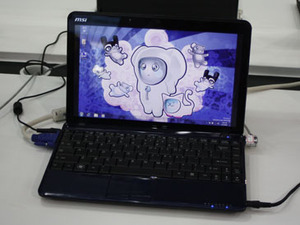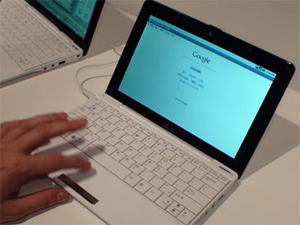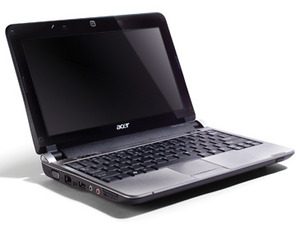
Other Trends: CULV and Netbooks
During the show, Intel made a big push with its CULV processors, which are part of the updated Montevina Plus platform. Montevina Plus is very much the same as the current Montevina platform, but it adds new CPUs, better video capabilities and improved networking.The graphics core has been boosted from eight shader units to ten, while video decode has also received a boost with native support for HDCP output over HDMI now implemented. On the networking front, the new Intel 82567 Gigabit network controller adds some new vPro security options and more aggressive power management.
The new 5000-series wireless radios also boast new features – the 5100 supports 802.11n and upto 300Mbps data transfers while its bigger brother, the 5300, adds Active Management Technology (AMT) and boosts transfer speeds up to 450Mbps.

Industry support for the new platform is already looking good
There are four new CPUs added as part of Montevina Plus – the P8800, P9700, P9900 and SU2700. The first three are dual-core 45nm Core 2 Duos with the P8800 running at 2.66GHz and the fastest, the P9900, clocked at 3.06GHz. There’s nothing particularly special about these chips – they continue on from where others have left off.
The SU2700, on the other hand, is something special, as it’s going to drive ultra portable notebooks down to very affordable price points. It’s a single core chip running at 1.3GHz with an 800MHz front side bus – it doesn’t sound like a lot, but it’s going to be a good deal faster than an Atom processor and machines based on it should start from around £450 and go up to about £800. It goes without saying, but that’s a mainstream price point and you’re going to see a lot of a thin, light and desirable laptops in that range.


MSI's U200 (left) and Asus's UX30 (right) - both are based on Intel's Montevina Plus platform and use the new CULV processors
Support is widespread and some examples of these new devices include the MSI U200, a 12in model weighing 1.4kg that should hit the lower end of the market, and Asus’s super sexy UX30 13.3in notebook, which weighs 1.6kg and measures 19.9mm at its fattest point and just 6.8mm at its thinnest. The latter, in particular, is one we’re really looking forward to getting our hands on.
Netbooks were, not surprisingly, everywhere at the show. We saw many new netbooks – some very promising, others not so promising, but the biggest news was that both Asus and Acer planned to introduce Google Android-powered netbooks at some point this year.
Asus’s model interestingly isn’t based on Atom; instead, it's exploring using Qualcomm’s Snapdragon platform and a 1GHz Arm CPU, which is capable of day-long battery life thanks to its extremely low power consumption and can handle 720p video playback like Nvidia’s Tegra chip. After the Qualcomm press conference, Asus backtracked and decided not to show this particular Eee PC at the show – we can expect to hear more about it later this year, I guess.


Asus's Snapdragon-based Eee PC running Android (image courtesy of Tweaktown) / Acer's Aspire One will soon ship with Android dual-booting with Windows XP
Acer, on the other hand, will ship its Android-based netbooks with Windows XP installed as well – that dampens the enthusiasm a bit, but Acer says that it’s a ‘play safe’ strategy because it isn’t sure how the general market will respond to it. We’ve all seen consumers avoid the many custom Linux distros out there and netbook makers have turned back to Windows XP because of that, so it’s understandable on Acer’s part, but it means its first Android-based netbooks will carry additional baggage. A shame.
Aside from the big Android news, Asus in particular was demoing a wide range of new netbooks in its Eee PC line. The one we’re most interested in is the Eee PC T91, which we had a very early look at in February. Software now looks like it’s about ready and it was demoed in a variety of usage models, including as a turn-by-turn SatNav device for mounting in your car.

MSI MPG Velox 100R Chassis Review
October 14 2021 | 15:04








Want to comment? Please log in.